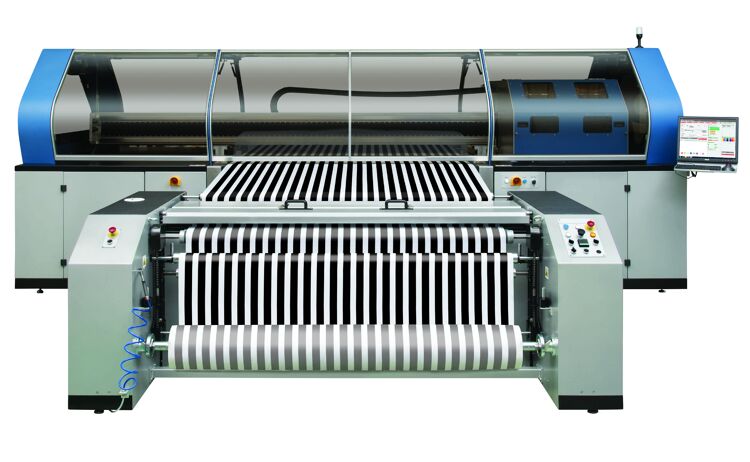Mimaki details environmental benefits of digital textile print

Mimaki discusses how companies can use digital textile print technology to improve their environmental image.
Mimaki Europe has spoken out about how companies can use digital textile print technology to boost their environmental image and pass these benefits to their own customers.
The manufacturer has reported a sharp increase in the number of customers that are seeking environmentally friendly solutions across all areas of print, citing the textile market as one area in particular where being green is key, due to the level of pollution from production.
Ronald van den Broek, general manager sales at Mimaki Europe, said: “Governments, especially in Europe, are moving to rein in this high level of pollution, especially as it affects water quality. As more textile manufacturing moves to digital, we will see less pollution by the industry.”
Mimaki offers a number of digital textile solutions, but picks out the Tiger 1800B textile printer as just one of its products where users can expect to experience a number of environmental benefits.
Featuring a top printing speed of 385sq m/hr, the Tiger 1800B is available as a direct-to-textile, reactive ink model, as well as in a sublimation, heat transfer version. Mimaki said that both editions can fit into high-volume production environments that have traditionally used using analogue printing methods.
The manufacturer also said that in addition to feeling the benefits of digital printing with higher volume applications, the Tiger 1800B can make it more efficient and cost-effective for the customer to produce short runs, customised fabrics and garments and samples.
“With production level products like the Mimaki Tiger 1800B, manufacturers of garments and home goods can take advantage of digital technology to reduce their environmental footprint, establishing a more sustainable operation while also providing brands and retailers with the benefits they are seeking,” van den Broek said.
“Mimaki was an early mover in digital textile printing, as early as 1998. Over the ensuing years, we have developed in-depth experience with printing on textiles and a robust textile printing offering. We have also brought to market an industry-leading array of inks that allows our printers to image just about any fabric on the market.
“With the Tiger 1800B, we have moved from entry-level and mid-range offerings to a true production model that will help speed the analogue-to-digital transformation the industry is currently undergoing. Digital textile printing has grown by an average of 30 percent over the past five years, and we believe it is poised to enter the hockey-stick phase of growth over the next couple of years.”
Industry members keen to find out more about the Tiger 1800B printer and the many other solutions available from Mimaki can see the manufacturer at FESPA 2018 this year. Taking place from May 15-18 at the Berlin Messe in Germany, the event will play host to the top names in global print, with thousands of visitors set to attend from around the world.
To find out more about the Global Print Expo, see the full exhibitor list and to see information about how you can register to attend, visit the event’s official website: www.fespaglobalprintexpo.com
For free entry use code FESJ801 when registering.
Topics
Interested in joining our community?
Enquire today about joining your local FESPA Association or FESPA Direct
Recent news

Streamlining personalisation with tech: Insights from the SmartHub Conference 2025 speakers
Personalisation Experience 2025 (6 – 9 May 2025, Messe Berlin, Germany) is running its inaugural SmartHub Conference from 6 – 8 May 2025.

Special Effects in DTF: How Neon Inks Are Making Apparel Pop
Neon fluorescent inks are the latest innovation in DTF printing, offering vibrant, eye-catching effects under both daylight and UV light, giving apparel decorators a competitive edge. Testing shows good wash durability, though market perception of added value is still developing. With increasing adoption and ongoing technological advancements, neon represents a significant upgrade for creative customisation.

Unlocking Growth Opportunities in the Printed Personalised Apparel Industry
The printed personalised apparel industry is booming, projected to reach $10.1 billion by 2030. Driven by consumer desire for self-expression and branding needs, technological advancements like DTG/DTF and e-commerce integration are key. Sustainability, eco-friendly materials, and on-demand printing are crucial growth drivers. Businesses leveraging these trends, including AI and social media, have significant commercial potential.

How to grow your business with white ink applications
Opaque white ink is revolutionising signage, vehicle graphics, wallcoverings, short-run and wood packaging, and window blinds by enhancing vibrancy and clarity. This enables printers to offer high-demand, standout products, boosting profit margins. HP Latex white ink applications and their large format printing solutions will be showcased at FESPA 2025 in Berlin.